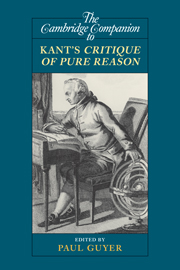Book contents
- Frontmatter
- Introduction
- Part I The Background to the Critique
- Part II The Arguments of the Critique
- 3 The Introduction to the Critique: Framing the Question
- 4 The Transcendental Aesthetic
- 5 The Deduction of the Categories: The Metaphysical and Transcendental Deductions
- 6 The System of Principles
- 7 The Refutation of Idealism and the Distinction between Phenomena and Noumena
- 8 The Ideas of Pure Reason
- 9 The Paralogisms of Pure Reason
- 10 The Antinomies of Pure Reason
- 11 The Ideal of Pure Reason
- 12 The Appendix to the Dialectic and the Canon of Pure Reason: The Positive Role of Reason
- 13 The Transcendental Doctrine of Method
- Part III The Impact of the Critique
- Bibliography
- Index
3 - The Introduction to the Critique: Framing the Question
from Part II - The Arguments of the Critique
Published online by Cambridge University Press: 28 July 2010
- Frontmatter
- Introduction
- Part I The Background to the Critique
- Part II The Arguments of the Critique
- 3 The Introduction to the Critique: Framing the Question
- 4 The Transcendental Aesthetic
- 5 The Deduction of the Categories: The Metaphysical and Transcendental Deductions
- 6 The System of Principles
- 7 The Refutation of Idealism and the Distinction between Phenomena and Noumena
- 8 The Ideas of Pure Reason
- 9 The Paralogisms of Pure Reason
- 10 The Antinomies of Pure Reason
- 11 The Ideal of Pure Reason
- 12 The Appendix to the Dialectic and the Canon of Pure Reason: The Positive Role of Reason
- 13 The Transcendental Doctrine of Method
- Part III The Impact of the Critique
- Bibliography
- Index
Summary
Many philosophical advances provide solutions to well-known difficulties. Others arrive instead in the shape of new problems. In the Critique of Pure Reason, Kant adopts the second approach - framing a new question. The Critique aims to revolutionize metaphysics, so demonstrating the salience of a previously overlooked problem was a natural first step. It allowed Kant to present his novel ideas for the system of philosophy as the answer to a compelling challenge: “How are synthetic judgments a priori possible?” (B 19). The job of the “Introduction” to the Critique is to frame this question properly, to articulate the distinctions needed to understand it, and to show its relevance to Kant's larger aims. My exegesis will focus on the second (B) edition version of the “Introduction.” Kant made substantial additions to this chapter in the second edition, but in my view, these alterations mainly aim to bring greater explicitness to points that were already present in the first, so I will trace the argumentative structure in its more fully articulated form. Kant's problem about synthetic a priori judgment must be understood in light of dominant currents in eighteenth-century philosophy, especially the extensive claims on behalf of conceptual truth made by G. W. Leibniz, Christian Wolff, and their followers.
- Type
- Chapter
- Information
- Publisher: Cambridge University PressPrint publication year: 2010
- 4
- Cited by



